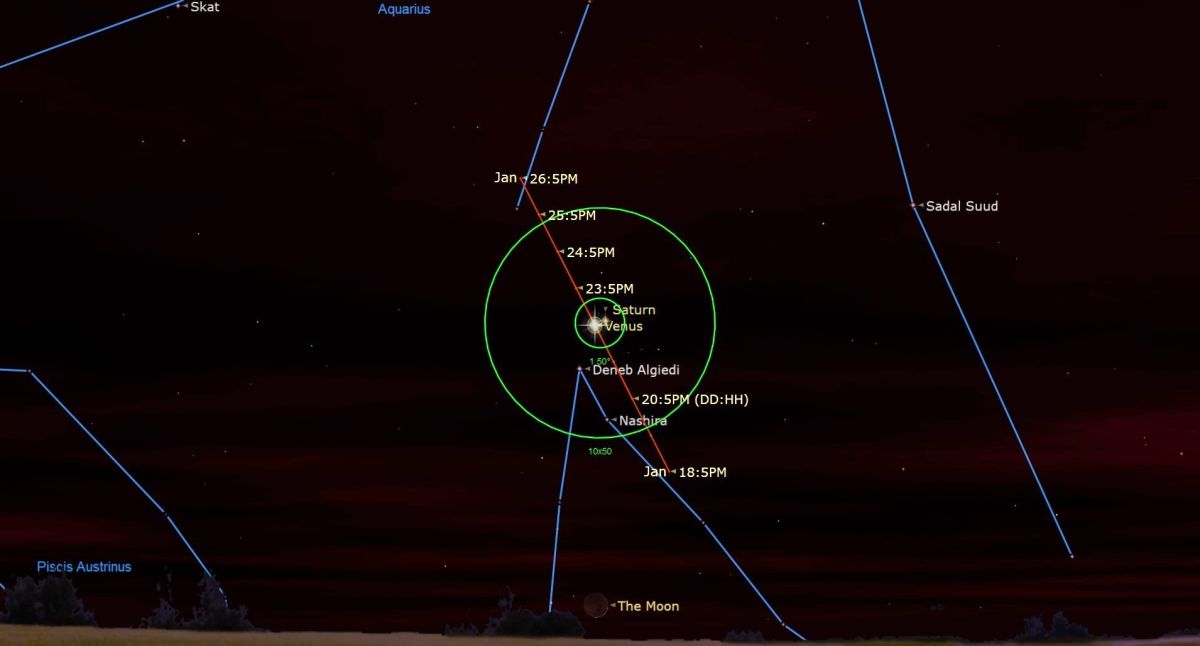On Sunday (Jan.22) the solar system planets Saturn and Venus will make a close approach to each other in the night sky, separated by no more than the width of a finger.
At the same time, the two planets will share the same right ascension (the celestial equivalent of latitude) in the sky in an arrangement that astronomers call a conjunction. At the time of the close approach, Venus, the second closest planet to the sun, and Saturn, the solar system’s second largest planet, will be in the constellation of Capricorn.
From New York City, the conjunction between Venus and Saturn and the close approach of the planets to each other will become visible in the constellation of Capricorn at around 5:18 p.m. EST (2218 GMT) at around 14 degrees over the horizon to the southwest, according to In the Sky (opens in new tab) . Following sunset at around 5:01 p.m. EST (2201 GMT), Venus and Saturn will sink towards the horizon and will set around two hours later at approximately 6:48 p.m. EST (2348 GMT).
Skywatchers not willing or able to brave the cold January evening to see Venus and Saturn can watch the event online for free thanks to the The Virtual Telescope Project. The project’s livestream of the conjunction of Venus and Saturn will begin at 11:00 am EST (1600 GMT) on Sunday (Jan. 22) and will be available to watch online for free courtesy of the project’s website (opens in new tab) or YouTube channel (opens in new tab) .
Related: See the conjunction of Venus and Saturn in free webcast on Jan. 22
During the conjunction, Venus will have a magnitude of around -3.9, with the minus prefix indicating a particularly bright object, while Saturn will have a magnitude of 0.7. The two planets will be separated by around half a degree, less that the width of the full moon in the sky, according to astronomer Gianluca Masi of the Virtual Telescope Project (opens in new tab) .
During the conjunction, Venus and Saturn will be so close together that the planets will be able to be seen together with a telescope. The conjunction will also be observable with binoculars or with the naked eye, though Saturn may be difficult to resolve due to the brightness of Venus.
The conjunction between Venus and Saturn marks the beginning of an exciting time for skywatchers to observe the former planet, as it marks the beginning of the evening apparition of Venus. This will see the second planet from the sun rise in the evening sky each subsequent evening, reaching its peak in late Spring by which point the planet will have more than doubled in brightness, according to Space.com’s Joe Rao .
As Venus is rising to its peak above the horizon, Saturn is following an almost opposite path reaching lower and lower points over the horizon each subsequent night and disappearing into the twilight as it does so. This will lead up to a solar conjunction between the gas giant and the sun on Feb. 16th, 2023.
If you’re hoping to get a great look at the close approach between Saturn and Venus, our guides for the best telescopes and best binoculars are a great place to start. If you’re looking to take spectacular photos of the event or the night sky in general, check out our guide on how to photograph the moon, as well as our best cameras for astrophotography and best lenses for astrophotography.
Editor’s Note: If you snap the conjunction between Saturn and Venus, and would like to share it with Space.com’s readers, send your photo(s), comments, and your name and location to spacephotos@space.com.
Follow us @Spacedotcom (opens in new tab) , or on Facebook (opens in new tab) and Instagram (opens in new tab) .
